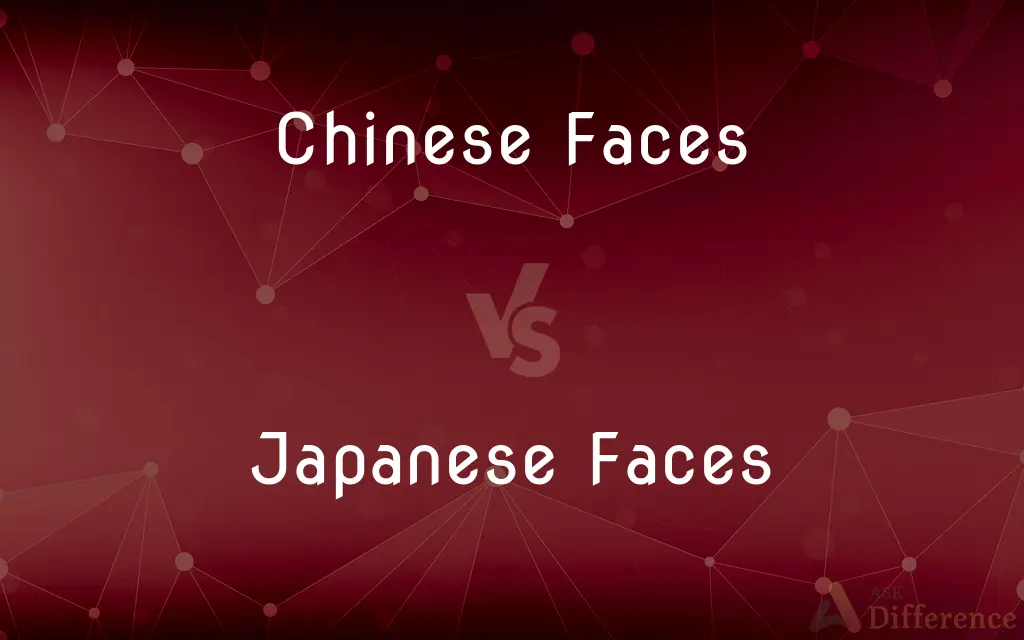Chinese Faces vs. Japanese Faces — What's the Difference?
By Tayyaba Rehman — Published on October 23, 2023
Chinese Faces refer to the facial features typical of Chinese people, while Japanese Faces refer to the facial features typical of Japanese people.

Difference Between Chinese Faces and Japanese Faces
Table of Contents
ADVERTISEMENT
Key Differences
Chinese Faces and Japanese Faces represent facial characteristics seen commonly among people of China and Japan, respectively. While there is immense diversity in both countries, certain generalized features might be more prevalent in one population than the other.
Some might claim that Chinese Faces often have a broader set of facial features, while Japanese Faces might be perceived as having more varied facial contours. However, it's crucial to understand that these are broad generalizations and not definitive characteristics.
Historically, because of geographical and cultural influences, there might have been variations in skin routines, cosmetics, and beauty standards, influencing the appearance of Chinese Faces and Japanese Faces differently. For instance, beauty standards in ancient China might have differed from those in ancient Japan.
Chinese Faces and Japanese Faces have evolved over centuries, with intermingling, migration, and other factors playing a role. Hence, any distinction can be blurred, making it challenging and often inaccurate to pigeonhole facial features based solely on nationality.
It's essential to treat Chinese Faces and Japanese Faces as descriptors, acknowledging the rich diversity within and not resorting to stereotypes or assumptions.
ADVERTISEMENT
Comparison Chart
Geographical Origin
Typically associated with people native to China
Typically associated with people native to Japan
Historical Influences
Influenced by various Chinese dynasties and their beauty standards
Influenced by various Japanese eras and their beauty standards
Cultural Aspects
May reflect beauty practices, customs, and ideals from China
May reflect beauty practices, customs, and ideals from Japan
Diversity
Immense diversity due to China's vastness and multiple ethnic groups
Diversity due to Japan's history and regional differences
Common Misconception
Sometimes stereotyped as having certain fixed features
Sometimes stereotyped as having distinct features from other East Asian nationalities
Compare with Definitions
Chinese Faces
Chinese Faces refer to facial characteristics commonly found among people from China.
Traditional paintings often depict Chinese Faces reflecting the beauty standards of their respective dynasties.
Japanese Faces
Japanese Faces refer to facial features typically associated with people from Japan.
Traditional Ukiyo-e prints often portray Japanese Faces based on the era's beauty standards.
Chinese Faces
Chinese Faces can exhibit regional variations due to China's vast landscape.
Northern and Southern Chinese Faces can sometimes display subtle differences.
Japanese Faces
Japanese Faces can be seen as a blend of genetics and cultural influences unique to Japan.
Japanese Faces have been shaped by a rich tapestry of historical events and cultural practices.
Chinese Faces
Chinese Faces might showcase the vast ethnic diversity within China.
The diversity in Chinese Faces represents the country's rich tapestry of ethnicities.
Japanese Faces
Japanese Faces can vary widely, reflecting Japan's regional differences.
Japanese Faces from Okinawa might differ subtly from those in Hokkaido.
Chinese Faces
Chinese Faces reflect the influence of historical beauty practices and ideals.
Ancient Chinese Faces in artworks reveal historical beauty norms.
Japanese Faces
Japanese Faces mirror the nation's history, art, and changing beauty standards.
Heian era Japanese Faces depicted in literature had specific beauty ideals.
Chinese Faces
Chinese Faces are a blend of genetics, history, and culture unique to China.
Chinese Faces tell a story of the nation's past and its cultural journey.
Japanese Faces
Japanese Faces, like any other, are individual and unique, beyond general characteristics.
While there might be general traits, every Japanese Face tells its own story.
Common Curiosities
How have history and culture influenced Chinese Faces?
Beauty standards, art, and historical influences over centuries have shaped perceptions and representations of Chinese Faces.
Can I reliably tell someone's nationality by their face?
It's unreliable and often inaccurate to judge nationality solely based on facial features.
How are Japanese Faces depicted in traditional art?
Traditional art forms like Ukiyo-e showcase Japanese Faces based on the era's beauty ideals.
Are there regional differences in Chinese Faces?
Yes, due to China's vastness and multiple ethnic groups, there can be regional variations.
How do media and popular culture influence perceptions of Japanese Faces?
Media plays a significant role in shaping beauty ideals and perceptions of Japanese Faces, both within Japan and internationally.
Are there only one type of Chinese and Japanese Face?
No, there's immense diversity within both populations, and facial features can vary significantly.
Are there any common misconceptions about Chinese and Japanese Faces?
Yes, there are stereotypes and misconceptions, but it's essential to treat individuals as unique and not generalize.
Are Chinese Faces and Japanese Faces very distinct?
While there might be generalized differences, there's significant overlap, and individual features can vary widely.
Is it offensive to make assumptions based on Chinese or Japanese Faces?
Yes, making assumptions or stereotyping based on facial features can be offensive and inaccurate.
How have beauty standards evolved for Japanese Faces?
Beauty standards have evolved over different historical eras, influenced by culture, art, and societal norms.
Do Chinese and Japanese people share any facial features?
There might be some similarities due to genetic factors, but there's also a lot of individual and cultural variation.
Is it essential to understand the cultural context when discussing Chinese and Japanese Faces?
Absolutely, understanding cultural context helps avoid generalizations and appreciate the rich history and diversity of both groups.
Do Chinese Faces reflect the country's diverse ethnic groups?
Yes, China's diverse ethnic groups contribute to a wide variety of facial features.
Are beauty practices different for Chinese Faces and Japanese Faces?
Both countries have unique beauty practices and ideals, influenced by history and culture.
Can Chinese Faces and Japanese Faces be found outside of their respective countries?
Yes, due to global migration, you can find individuals with these facial features worldwide.
Share Your Discovery

Previous Comparison
Either vs. Neither
Next Comparison
Frugality vs. StinginessAuthor Spotlight
Written by
Tayyaba RehmanTayyaba Rehman is a distinguished writer, currently serving as a primary contributor to askdifference.com. As a researcher in semantics and etymology, Tayyaba's passion for the complexity of languages and their distinctions has found a perfect home on the platform. Tayyaba delves into the intricacies of language, distinguishing between commonly confused words and phrases, thereby providing clarity for readers worldwide.
















































